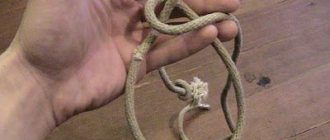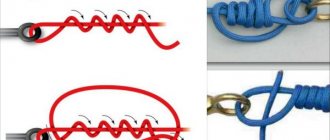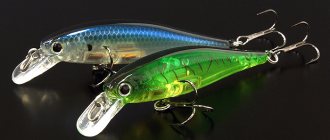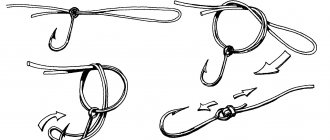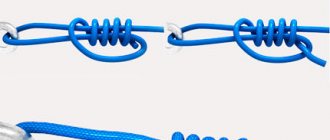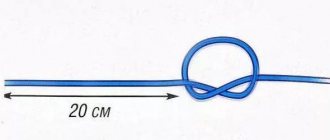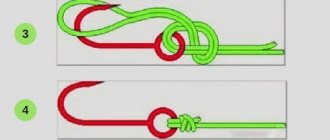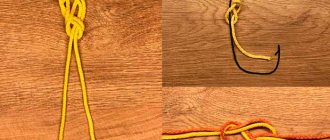morskoj uzel
To tie a sea knot correctly, first of all, you need to remember that the fixed end of the rope is called the main end, and the movable end is called the running end. There are several simple examples of knitting that are useful both at home and during outdoor activities.
- 1 How to tie a bowline knot
- 2 Knitting a figure eight sea knot
- 3 Scheme for knitting a direct sea knot
- 4 Half bayonet and bayonet
- 5 How to tie a fisherman's bayonet knot
- 6 Scheme of the thieves' sea node
- 7 How to tie a woman’s and mother-in-law’s knot: a simple diagram
- 8 Types and methods of performing a noose knot
How to tie a bowline knot
It is also called a gazebo and is classified as a fundamental node. It contains elements of several schemes, which gives it universal properties: the fastening allows mooring, securing sailors, and fixing the rope to the hook. The bowline is very reliable, it can be used with almost all cables, regardless of material and thickness. The gazebo is quickly tied and easily untied (but not spontaneously), it does not slip, and is highly reliable when used in marine conditions.
Bowline knot
Sea knot tying pattern for beginners:
- Form a loop from top to bottom.
- Pass the running end through it from bottom to top.
- Pass the chassis behind the main one and pass it through the loop again.
- When the running end is enclosed in the small loop formed, the rope must be tightened tightly.
To untie the bowline, just move the loop slightly in the direction from the running end to the root end.
Origin of the term "maritime knot"
Shipping is one of the oldest human activities. It is obvious that in ancient times there were no compasses, locators, navigators and other technical achievements of later times. However, sailors needed to look for some landmarks in order to determine their location. They navigated by the stars, the moon, lighthouses, the outlines of coastal relief, and so on.
A special invention was used to determine the distance traveled. It was called a log and was a log with a rope tied to it. Knots were tied on the rope at equal distances from each other. The log was thrown from the stern of the ship. When the rope was stretched, the sailor counted the number of knots passed through his hands during the movement of the ship.
This is how the tradition of measuring speed with sea knots was established, although the modern knot has a different size than in ancient times. In modern navigation, the log is still used to measure the speed of the ship. It looks, of course, different than in the past, and is a special device.
So, at sea, the calculation of speed in sea knots has been carried out since ancient times. A knot corresponds to the speed at which a ship will travel one nautical mile in an hour. To convert speed in knots to speed in kilometers, multiply the knots by 1.852 (the length of one nautical mile).
Knitting a figure eight sea knot
This is a typical modification, which got its name due to its characteristic shape. The figure eight is usually used to form a stopper or stable fastening. The main advantage is that it is easy to deal with, even if the rope gets wet.
Figure eight knot
How to knit a sea knot:
- Circle the running end of the main one, pull the first one from above so that you get a loop.
- Pierce the resulting loop with the running end so that you can then pull it behind you.
- Tighten.
Knitting pattern for a straight sea knot
One of the oldest modifications, in Ancient Greece the knot was called the Hercules knot. With its help, you can firmly connect two ropes having approximately the same diameter. But the scheme cannot be called reliable: under heavy loads, the joint will be overly stretched, and it will often slide along the cable. It is not recommended for use in critical situations or when activities involving immersion in water are planned.
Straight knot
Classical technique:
- Take 2 running ends of the cables, one should cover the second.
- The other end forms an open loop.
- It is necessary to stretch the rope into this loop so that the first end is also braided.
- Tighten both ropes.
There is a subtype of the direct knot - the reef knot, which is distinguished by its ability to quickly untie.
Half bayonet and bayonet
The half-bayonet is not tightened; to perform it, the running end is wrapped around the object on which it is planned to fasten the cable, the main one is circled and passed through the formed loop. Next, both ends are fastened together. The unit can withstand heavy weight and is reliable.
Bayonet Knot
Using a bayonet, the mooring ends are fixed and towing is performed. It is based on 3 half-bayonets - this quantity is enough for any purpose. It cannot be assumed that 4 or 5 half-bayonets are stronger; the effect when used will be the same.
The principle of operation of the first lags
Sector log
The earliest example of a log is an ordinary log or board with an attached cable - a tench (lagline). While the ship was moving, the device was thrown overboard from the stern. It was held on the water surface with the help of lagline extensions at several points, which made it possible to occupy a perpendicular position relative to the direction of travel of the ship.
Interesting: Is it possible to refuel a civil aircraft in flight?
Measuring ship speed
Due to the braking of the sector by water, the line was fed approximately at the speed of the ship. The sailor determined the length of the line going overboard for a fixed time, most often 30 or 60 seconds. To do this, knots were tied on the cable at equal intervals, which were then counted. The distance between the knots was set in advance so that the number of knots reflected the speed of the craft. As a result, the new unit received the name node .
Let's give an example
If the log is divided into sectors, the intervals between which are 50.7 feet (identically 1/120 of a nautical mile) with the object moving at a speed of one knot, the device can move two knots (1/60 of a mile) in 60 seconds, and in 30 seconds - 1 knot. It turns out that if ten knots are etched in 30 seconds, the ship’s speed is 10 knots.
Interesting : The correct use of the term is that the ship is moving at full speed at thirteen knots, but it is incorrect to say thirteen knots per hour.
How to tie a sea knot with a fisherman's bayonet
Marine knot fisherman's bayonet
This variation has ancient roots; it has survived to this day due to the fact that it allows the rope to be fixed as firmly as possible on the anchor, and is adapted for all types of manipulations in conditions of strong traction. Initially, you need to secure the cable to the object using additional hose, then you can begin to form half-bayonets. The first of them must capture the barrier encircling the base.
6.2. Sea knots
Home / Publications / Literature / Bookshelf / Handbook of maritime practiceThe simplest and most common way to connect two plant cables is to tie them together with one of the sea knots. Connecting steel cables with knots should only be used in cases of extreme necessity, since due to sharp bends of the wires, the tensile strength of the cables will be weakened and they will receive significant damage. Each sea knot must meet the following basic requirements - quickly tie and untie, and not unravel spontaneously. The following main types of maritime knots are widely used in maritime practice (Fig. 6.2).
Rice. 6.2. Mop knots: 1 - straight; 2 - reef; 3 - flat; 4 - simple bayonet; 5 — bayonet with hose; 6 — bayonet with trim; 7 — fishing bayonet; 8 - bayonet with its ends; 9 - bayonet with foreign ends; 10 — bleaching unit; 11 — buoyed knot; 12 — retractable bayonet; 13 - gazebo unit; 14 — double arbor knot; 15 - pile; 16 - clew; 17 - noose; 18 - hook; 19 — double hook; 20 - towing; 21 - boat; 22 - barrel; 23 - top; 24 - turnbuckle; 25 — knot for tying reef pins into the sail; 26 - eight; 27 - locking; 28 - gynce; 29 - tying the throwing end to the mooring line.
Straight is used to connect two cables of approximately the same thickness. With strong tension and wetness, the straight knot becomes tight and can be very difficult to untie. Therefore, when tying thick cables with a straight knot, it is necessary to insert brakes into the knot. When the knot is correctly tied, the running and main ends of each cable should be on the same side of the loop.
Reef is used when the cables need to be tied with a reliable, quickly untied knot, for example, when taking reefs on sailing ships, fastening the upper ropes of moorings on bollards. Unlike a straight knot, the running end of one of the cables is inserted into the knot in a loop.
Flat is used to connect two cables of different thicknesses, which will be subject to significant tension and wetness. Usually a flat knot is knitted on the deck, for which the thicker cable is folded in the form of a loop, and the thin one is sequentially passed under the loop on top of the main one, then under the running end of the thick cable and over the loop of the thick cable under its main end. The running ends of both cables are tied with half bayonets and secured with a line or skimushgar.
A simple bayonet is used to connect two thick cables. The knot is knitted with two overlaps of the running end around the main part (two half-bayonets), then the running end is attached to the main end using a line or skimushgar. When the knot is tied correctly, after the half-bayonets are brought together, a bleached knot is obtained. With a strong tension on the cable, the simple bayonet is tightened. Varieties of a simple bayonet are a bayonet with a hook and a bayonet with a bayonet. Unlike a simple bayonet, they do not creep or tighten.
A fishing bayonet is used to fasten a cable with a reliable and easily untied knot (for example, to fasten a draught to a dreck bracket, fasten a mooring line that does not have a fire at the end). Unlike a bayonet with two hoses, when knitting a fishing bayonet, the second hose is not tightened, but the first half-bayonet is placed on both hoes. Even with strong tension, the fishing bayonet does not tighten and can be easily untied.
Tying with cable pins is carried out in two ways: bayonets with their own ends and pins with WHICH ENDS. In the first case, the end of one of the cables is folded into a loop and secured to its root part with two or three half-pins. The running end of the second cable is passed into the loop, which is secured in the same way to its root part. In the second case, the cables are fastened with half-bayonets. Steel cables can also be connected using these methods.
When tying cables of significant diameter, especially steel ones, with these knots, it is necessary to firmly connect them together with a line or skimushgar, enclosing the contraction guards in a figure eight so that the knots cannot creep, tighten or come undone.
The pulled out knot is one of the most tightly tightened knots. It is used when attaching the casting end to the mooring rope (in this case it is supplemented with a loop), backstraps on boats, and shrouds to the shrouds. When tying a knot, the running end is wrapped around the object, crosses the applied hose, is again wrapped around the object and passed under the crossing hose. A variation of the bleached knot is the buoyed knot, superimposed on the anchor trend. In the latter case, the running end of the cable has a button and is attached to the anchor spindle with a mark.
The sliding bayonet is also a type of tapping unit and differs from it in that it has not two, but three hoses covering the object. The unit is used when lifting spar parts, logs and other objects with a smooth surface.
The belly line is used at the safety end when working on superstructures and overboard the ship. The gazebo knot does not tighten and can be tied to itself. When tying a knot, a loop is made on the cable. The running end of the cable is led into a loop, goes around its root part and again passes into the loop in the opposite direction. A type of arbor knot is a double arbor knot. In this case, the knot is knitted with the running end of the cable folded in half, forming loops of various sizes. The large loop serves as a seat, and the small loop covers the torso under the arms.
The welder is used when supplying various tools to those working overboard or on superstructures and when working with piles. When tying a knot on the cable, a loop is made into which the pile is inserted.
The sheet is used for tying cables, one of which has a thimble or fire, and also for tying sheets to sails. The clew assembly holds securely when the cable is under tension. A type of clew knot is the bram clew knot. In this case, the running end of the cable is wrapped twice around the neck of the thimble, fire or loop.
A knot is a knot that is knitted on various objects (a log, a spar). To tie a knot, the running end of the cable is wrapped around the object, the root part of the cable goes around and wrapped 2-3 times around the hose placed on the object. A type of noose is a hose noose. In this case, the knot is supplemented with a separate hose applied to the object.
The hook is used when attaching large diameter cables to hooks. The hook knot is designed for small cable tensions. A type of hook knot is a hook knot with a hook, which is used when attaching thin cables to a large-diameter hook. In this case, the running end of the cable is wrapped twice around the neck of the hook. The running end of the rope of the hook assembly is grabbed with a line or skimushgar to the root part.
A double-gang is used when the cable is subject to significant tension. When tying a knot on a cable, make two loops of the same size, cover them with three cable hoists and put them on the hook.
The running end of the cable under the hook is fastened to the main part with a line or skimushgar.
The towbar is used for attaching cables to a towing hook or biting. The unit allows you to change the length of the cable if necessary. When tying a knot on the running part of a cable put on the hook, make a loop and, passing it under the main part, put it on the hook. Subsequently, 3-4 more loops are put on the hook on the left and right. Then the running end is attached to the root part of the cable (tug) with a line or skimushgar.
The boat ropes are knitted when placing the traveling end on the boat, when placing the boat on the backstrap or towing the boats. The running end is passed into the bow eye or attached to it using a shimushgar and passed under the first can. Then the cable is carried around the second can, passed over the cable, crossing it, and passed in the form of a loop under the hose encircling the can.
Barrel is used when loading various types of containers (barrels, cans, etc.). To do this, a semi-straight knot is knitted on the middle part of the cable. The half loops of the knot are pulled apart and cover the middle part of the object. The lower loop passes under its bottom.
The top type (mast type) is used when installing temporary guy ropes for installing masts, piles, etc. When tying a knot on a cable, three loops are made in succession. The inner parts of the first and third loops are carried out to the right and left. The first loop is drawn between the second and third; the third - to the left between the second and first loops. In this way, two side loops are obtained, and the third is formed in the middle. The knot is put on the object being installed with the middle loop, and the side loops are used for attaching guy ropes.
Rope lanyard (rope lanyard) is used for tightening and fastening various gear (shrouds).
Knots for tying reef - sterns in a pair are tied on both sides of the sail. To do this, two loops are made at the ends of the cable passed through the eyelets. The ends of the cable are passed through them and the knot is tightened.
Eight is a knot that is used to prevent the cable from sticking out of the block. It can be tied in two ways. In the first case, a small loop is made at the end of the cable, into which the running end enclosed around the cable is passed. In the second case, the running end is wrapped around the cable twice and then also passed into the loop.
The stopper is placed on the cable with 2-3 hoists, then the running end is wrapped around the cable in the direction of traction and secured to it with a line or skimushgar. The knot is used to lock cables under tension. For steel cables, a rigging chain is used in a similar way.
Gintsev is used when attaching cables to a fire with a thimble. The end of the cable is wrapped around the neck of the thimble twice, both hoses are covered with the root part of the cable and inserted into the thimble in the form of a loop. Then a wooden brake or pile is inserted into the loop.
Tying the end of the mooring line to the mooring line is done with a tapping knot with a loop or a bayonet with a loop. The throwing end is tied to the side of the mooring line so that it does not get pinched when putting the line on the pole.
Connecting synthetic cables with knots is not practiced due to their high elasticity and smooth surface (the knots creep).
Forward Contents Back
Scheme of the thieves' sea hub
Scheme of a thief's sea knot
If the ends of the rope are not visible, outwardly this knot cannot be distinguished from a straight one. It got its name due to the fact that this similarity was actively used on ships in order to identify the theft of sailors’ personal property and provisions. The connection is used mainly for domestic purposes, since when tensioned, the knot can spontaneously come undone.
How to tie a woman's and mother-in-law's knot: a simple diagram
The variations are extremely similar: these are two erroneous ways of forming a thief's knot. The names “woman’s” and “mother-in-law” are based on everyday specificity of use - they are widely used to connect ropes, but do not take into account the unreliability and even some danger of sliding fastenings.
Babi knot
Knitting a sea knot is not difficult: two running ends are passed through each other in different directions and duplicate this action in a mirror image.
Professional sailors and adherents of an active lifestyle demonstrate the woman's knot only for educational purposes, since its use in field conditions is fraught with injury and damage to property.
The mother-in-law's knot differs from the woman's knot in that here the ends of the cable come from the finished combination in a diagonal direction. The modification was first used in European countries in shipping, but was later replaced by more practical and strong knitting options that do not have the ability to unravel spontaneously. Now, in practice, it can only be found in subsidiary farming as an auxiliary link for packaging raw materials and food products.
To perform the mother-in-law knot you should:
- Form a partial loop from the running end of one rope.
- Pass the second end into the loop from top to bottom, go around the first rope and bring it out.
Even if you tighten it tightly, there is a high probability that with further tension the ligament will open.
How to tie tourist knots
Rope is an indispensable assistant in everyday life and an important item on hiking trips. With its help you can cross the river, make insurance, arrange a sleeping place and much more. Therefore, when planning a long hike, every traveler should take several ropes and learn in advance how to tie tourist knots - strong and multifunctional.
What are the types of nodes?
Any tourist hubs must:
- knit without extra effort;
- withstand different weights and loads;
- do not slip or compact without additional tightening.
There are many tourist knots, so you need to be able not only to tie them, but also to distinguish them by types and methods of use:
- tie identical ropes with “counter, weaving, straight, grepwein”;
- connect different ropes using variants whose names sound like “academic” and “branchboard”;
- to tie ropes to something, use a “noose, stirrup” or “bowline”;
- to create non-tightening knots, use “eights”, “double conductors”, “middle Austrian conductors”, “simple conductors”;
- don't forget the extra nodes called auxiliary nodes.
Below are diagrams and descriptions of how to knit basic knots.
Straight knot
We knit a straight knot in one of two ways:
- Fold a loop on the rope, take the second one and wrap it around the first one, leaving fifteen or twenty centimeter edges. The ends must point in the same direction, otherwise the knot is tied incorrectly.
- Place one rope on top of the second, tie two simple knots on opposite sides of the junction.
weaving knot
Tie a couple of knots on two ropes folded together, pull, secure. This version of the knot sometimes becomes deformed, becomes denser, but can weaken depending on the load it has to withstand.
Counter knot
Tie simple knots on both ropes so that they are in the opposite direction. The tails of the double knot should stick out in different directions.
The counter knot is not loosened, but can be tightened more tightly. Suitable for tying identical ropes.
Grepwein
Fold two ropes, tie two knots and pull them together. The operating principle is shown in the diagram.
Grepweins are tourist knots used to connect ropes of different thicknesses. Under the influence of weight, they tighten more strongly, but do not require additional fixation.
Bramshkotovy
Thick rope is used for a loop, which is wrapped with thinner rope. The finished knot is pulled together and straightened.
Academic
The scheme is similar to the bramshkot one. A thicker rope is used to make a loop, which is wrapped with a thin one. The result is tightened and fixed.
Eight
To tie a figure eight, form the same number at the end of a rope folded in half and tighten it as shown in the diagram.
The figure eight knot will allow you to obtain loops that do not deform under the influence of weights.
Bowline
Knits with support. The loop is formed counterclockwise with a rotation of 180 degrees. First, it is wrapped with the free end, which is then threaded into the loop. How the bowline knot is formed correctly is shown in the figure.
An option not suitable for variable loads, but remains stable under heavy weight.
Simple Explorer
A “simple guide” can be tied in any area. Not suitable for hard ropes where they become very compacted or, conversely, “creep”.
Middle Austrian guide
From a folded rope, make a figure “eight” on any section, turning it 360 degrees.
Double conductor
The second name is “rabbit ears”. Fold the rope in half to form a “dummy”. Thread the upper “ears” into the bottom loop.
A double conductor should be obtained without crossings. It does not need additional fixation.
Noose
You need to knit tourist “nooses” on the working part, wrapped several times with the running end tied to a support.
Auxiliary nodes
Auxiliary options include: * Dummy - the basis for the “double conductor” and “bowline”. Unties without much effort. * Marking * Stirrup
Most of the main components are attached with additional ones for additional strength. These include: * simple; * stirrup; * weaving; * noose; * counter; * bramshkotovy; * academic; * bowline; * simple conductor.
Tourism requires the ability to use various nodes. Some of them can only be tied together with identical ropes. Remember that any variation, be it a simple knot, a clinch knot, a figure eight knot, a nautical knot or some other, must be tied correctly. Regardless of what type of knots you plan to use on a hike, each one requires special attention. How safe and comfortable the hike will be for the entire group depends on the skills of the tourist.
